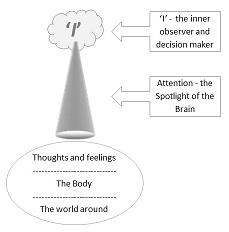The Attention – Spotlight of the Brain

We think about something most of the time – big
or small. The question is: Who is actually experiencing
these thoughts? The answer is simple: I am.
Every human has an ‘I’ inside. What this ‘I’ constitutes, is a complex question that we don’t need to answer here. For now, it is enough for us to realise that we all have an ‘I’ that everybody recognises.
The ‘I’ experiences the world throught attention. This attention is a kind of invisible spotlight that enables us to discover the world.
‘Your world’ consists of three parts:
- The world around you (people, nature, things), that you can see, hear, feel, smell and taste.
- The body – which you can feel.
- Thoughts and feelings that you experience inside yourself.
It is a bit like the spotlight on a stage: the spotlight highlights what is most important on stage at the moment.
The ‘I’ experience what the attention highlights.
The ‘I’ is the lightning operator.
The attention is the spotlight, and the stage is the world around and inside us.
Attention and resilience
When you deal with small and big challenges in everyday life it´s useful to be in control of your attention. This enables you to:
- Stay focused on tasks and thoughts that are important even though you are surrounded by distractions.
- Release yourself from thoughts and feelings which may be disruptive if you stay with them for too long.
- ‘Scan’ your external and internal world and discover exciting and important things.
(Exercising your attention is therefore a good idea. It is easily done. Look here)
A Mind-model of the World
From the first moment of your life, you build a mind-model of the world inside your brain. Take a look at an object in front of you and you will discover and experience the object in a second. Close your eyes and you are able to visualize the object even though you cannot see it. You have a mind-model of the object that you can experience as well. More than this, you can imagine things that do not exist in the real world.
Your entire world is inside your mind-model. Your relations to other people – values, rules and beliefs – are important parts of our internal model of the world. Even though we think we may share everything, different people have different mind-models of the world – for better and for worse.
You also experience ‘who you are’. This is your self-image – your identity. Your image of yourself is a pattern of thoughts and feelings about yourself that you experience within yourself. A part of your self-image is constant, while other parts keep changing throughout life.
The mind-model is somehow like an inner computer game and role-play-game. The more varied knowledge and experiences you add and the more you play with your extraordinary mind-model, the more you master. If you remain curious and spend time with very different kinds of people it become easier to create an exciting and dynamic inner mind-model.
It is good to be critical but if you become too critical, your mind-model will shrink.
The brain constantly compares what it recieves to what it already knows (the mind-model). It classifies what is important and what is not. Even what you are reading right now is compared to what is already in your mind-model.
The invisible.
Thoughts and feelings are invisible events inside of us that we all experience. Thoughts and feelings are important and practical. They can be lovely and exciting. They can also be tiring and unpleasant. Thoughts and feelings have consequences, especially when they are carried out via small or big actions.
Discovering invisible events is naturally harder than to discover what can be seen in the world. Therefore, it is not until the age of 3-5 years that children gradually realise that invisible events are taking place in their own and other people’s heads – that is, being able to think about their own and other people’s thoughts and feelings. From this point it is a voyage of discovery throughout life to understand and use our thoughts and feelings to create joy and benefit for ourselves and other people.
Fortunately, the invisibility gives us freedom to think whatever we want. At the same time this invisibility makes it difficult to know what other people think. We may misunderstand and believe that another person thinks of one thing, while he or she actually is thinking something else. Misunderstandings may cause conflicts. A few simple rules can prevent conflicts:
- Slow down the pace of a conversation if there is a risk of misunderstanding and conflict – this allows time for all participants to think things over. Allow for pauses as well.
- Be curious to understand. Good questions could be:
“Tell me some more about…”.
“Could this be because … – or is there a totally different reason…?”
“What do you think we could do…, right now…, later…?”
“Would it make any sense to you if we try to…?”
When you keep in mind that in a conflict the ‘attacker’ fells trapped and is actually trying to defend themselves, it´s easier to avoid being trapped yourself in to a defensive or aggressive position. Instead, keep neutral and hereby help to scale down the conflict (read more: The thinking brain and the alarm centre and Make the invisible visible).
Who decides?
The ‘I’ can settle on thoughts and feelings from one second to another by shifting the focus of attention to what the ‘I’ wants to think about – right now. The ‘I’ can eventually absorb itself in to something exciting and delightful.
However, the ‘I’ is not always in control: important events in the inner or outer world may attract the focus of attention – even though the ‘I’ doesn´t want them to:
- The ‘I’ can get frightened if something seemingly dangerous happens, with or without reason.
- The ‘I’ can feel unwell if an unpleasent feeling becomes overwhelming.
- The body or head can be aching so badly that ‘I’ can’t think about anything else.
The ‘I’ holds one end of our attention and the events in the outer and inner world hold the other end. Every second throughout life we find ourselves in an ongoing game of who is in control of our attention – the ‘I’ or the events of the outer and inner world.
Your personal freedom has to do with your decisions towards events in your life. When YOU decide what you want to think about right NOW you are actually practicing your ability to control your thoughts and feeling instead of the other way around.
Read more:
The Story of The House of Thoughts
The story of a Mind-Train
ADHD
Self-deception
Breathing
Everyday Meditation – for Children as
